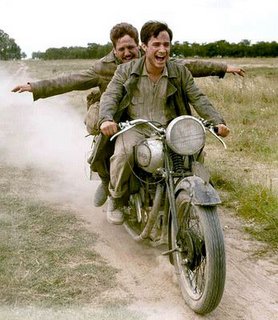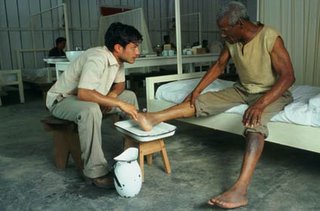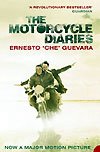
Ernesto 'Che' Guevara was one of the most enigmatic personalities of the 20th century. There have been so many myths and legends about him, he's been a revolutionary's icon and at the same time has also been a fashion icon. His looks the trademark headgear with a star have made him a popular picture to be put not only on T Shirts (for both the sexes) but he has been a design on women'swear as well! I got my first taste of Che when Tirumalesh wrote a long poem titled "Boliviadalli Che" (Che in Bolivia).
I bought the book Motorcycle Diaries in 1999.
 Usually I put my name and date only after I read a book, but somehow this book was always there and I never got to read it. It was only when I found two other books by Che - "Back to the Road" and the "The African Dream" (in Sankar's at Bangalore Airport), that I decided to give these a serious read. I read Motorcycle Diaries a few months ago, when I got to know about the movie that was made based on this book. I was very curious to know how the movie was made. It is one matter to translate fiction or a story into a movie, but to make a travelogue - written partly in the form of a journal and partly in the form of letters into a movie (and also to re-create the period in which the journey was undertaken) must have been a different experience. I therefore was wanting to see the movie also before I did a post on Che. Luckily I got hold of a DVD of Motorcycle Diaries and saw it recently.
Usually I put my name and date only after I read a book, but somehow this book was always there and I never got to read it. It was only when I found two other books by Che - "Back to the Road" and the "The African Dream" (in Sankar's at Bangalore Airport), that I decided to give these a serious read. I read Motorcycle Diaries a few months ago, when I got to know about the movie that was made based on this book. I was very curious to know how the movie was made. It is one matter to translate fiction or a story into a movie, but to make a travelogue - written partly in the form of a journal and partly in the form of letters into a movie (and also to re-create the period in which the journey was undertaken) must have been a different experience. I therefore was wanting to see the movie also before I did a post on Che. Luckily I got hold of a DVD of Motorcycle Diaries and saw it recently.  In the edition I have, the cover page proclaims "Easy Rider meets Das Kapital" (The Times), on the back cover it proclaims "It's true; Marxists just wanna have fun" (Guardian). It is a sick way of describing a book and I do not think it is a mature way of responding to a person who had his own convictions - however much one may not want to agree with those ideological arguments. It is not in good taste, also because it takes away the literary merit of this work - which has got nothing to do with the eventual participation of Che in the Cuban revolution and later in Bolivia and Congo. However I guess this is more to do with one particular publisher than the general perception about Che.
In the edition I have, the cover page proclaims "Easy Rider meets Das Kapital" (The Times), on the back cover it proclaims "It's true; Marxists just wanna have fun" (Guardian). It is a sick way of describing a book and I do not think it is a mature way of responding to a person who had his own convictions - however much one may not want to agree with those ideological arguments. It is not in good taste, also because it takes away the literary merit of this work - which has got nothing to do with the eventual participation of Che in the Cuban revolution and later in Bolivia and Congo. However I guess this is more to do with one particular publisher than the general perception about Che.Che's book is all about that moment of truth and a journey that helps him to discover his geography, the history of this geography and has a lasting impression on his own future course of action. It certainly is not about ideology and the journey is not about having fun. Yes, Che does have fun on the way with his friend Alberto Granado - but that is incidental. The book chronicles the "here and now" moments of truth for Che and in retrospect we could possibly see that this journey had a lasting impact on how his later political life shaped up. The journey is not about the travails of the motorcycle crashing now and then, the quality of roads and about the romance of camping. The journey is all about meeting people, understanding the conditions under which they live and how they respond.
I reproduce two quotes from the early pages of the book to understand Che's thoughts:
This isn't a tale of derring-do, nor it is merely some kind of 'cynical account'; in isn't meant to be, at least. It's a chunk of two lives running parallel for a while, with common aspirations and similar dreams. In nine months a man can think a lot of thoughts, from the height of philosophical conjecture to the most abject longing for a bowl of soup - in perfect harmony with the state of his stomach.
Any book on photographic technique can show you the image of a nocturnal landscape with the full moon shining and the accompanying text revealing the secret of sunlit darkness. But the reader doesn't know what kind of sensitive fluid covers my retina......

So one part of the text is all about what he saw and experienced and the sub-text of the entire book is what it did to Che's personality. When he decides to undertake "a year long journey" his father does ask him - "What about your girlfriend?" and Che says that she would wait if she loved him. The journey is thus undertaken with a single minded focus and possible Che never got back to his girlfriend again. The entire journey is also about generating your own resources on the run - most of the time being broke and having to tell interesting stories to people to ensure that they get basic food, shelter and if things go on fine, some greater luxuries.
 Normally one is skeptical about films made from such texts. However, the film not only captures the spirit of Che's journey faithfully, it is an improvisation of the details given in the text. It continues in the spirit of the journey itself. In the book Che says "That's how the trip came about, and it never deviated from the general principle laid down then: improvisation". The film (in Spanish, with english subtitles) captures the beauty of the continent and also remains faithful to the spirit of the journey by these two friends.
Normally one is skeptical about films made from such texts. However, the film not only captures the spirit of Che's journey faithfully, it is an improvisation of the details given in the text. It continues in the spirit of the journey itself. In the book Che says "That's how the trip came about, and it never deviated from the general principle laid down then: improvisation". The film (in Spanish, with english subtitles) captures the beauty of the continent and also remains faithful to the spirit of the journey by these two friends. The interesting part of the improvisation is the five step anniversary routine they do for getting basic food and drink, which goes as follows:
- One of us says something in a loud voice immediately identifying us as Argentine, something with a che in it and other typical expressions and pronounciation. The victim asks where we are from, and we strike up a conversation.
- We begin our tale of woe, but don't make too much of it, all the while staring into the distance.
- Then I butt in and ask what the date is. Someone says it and Alberto sighs and says: 'What a coincidence, it was exactly a year ago.' The victim asks what was a year ago, and we reply that was when we started out on our trip.
- Alberto, who is much more brazen than me, then heaves a tremendous sigh and says, 'Shame we're in such dire straits, we won't be able to celebrate' (he says this as a kind of aside to me). The victim immediately offers to pay, we pretend to refuse for a while saying we can't possibly pay him back, etc., then finally we accept.
- After the first drink, I adamantly refuse another and Alberto makes fun of me. Our host gets annoyed and insists, I keep refusing but won't say why. The victim keeps asking until I confess, rather shamefacedly, that in Argentina it's the custom to eat when we drink.....
When I talk about improvisation in the film an entire myth is built around $15 said to be given by Che's girlfriend to buy a nightgown for her from Miami, a piece that does not appear in the book. (I am not sure if it was picked up from Alberto, or just cooked up, but nevertheless it is indeed an interesting 'improvisation'). Throughout the film Alberto tries to get Che to spend it on some aspect or the other - but without success.

The book also talks about a strangely shaped fish which the locals call bufeo. Che says "It is apparently a river dolphin which has, among other strange characteristics, genitals like a woman's, so the indians use it as a substitute, but they have to kill the animal when they've finished coitus because a contraction in the genital area stops the penis coming out." In the film this story is narrated by a whore while she is luring Alberto. And Alberto does get lured - to the extent that he insists that Che give the $15 to him immediately.
But that is when we get to know that Che has given away the money to the mine worker couple. This part is poignant and symbolic. This is a time marker which possibly indicates that Che moves away from his girlfriend towards people - the exploited with whom he intends to spend his future.
The second most poignant part of the movie is towards the end when after a toast on his birthday in the staff area of the San Pablo leper colony, Che swims across a river to reach the patient area to wish them goodbye. This swim across - to reach to the other side is also a hard hitting scene symbolising the making of Che's overall personality. The film captures this (with retrospective knowledge of what Che eventually became) brilliantly.

 It is one of the few occasions where I have equally admired the book and the film made based on the book. The last time I enjoyed the cinematic portrayal of a text was when Shyam Benegal made "Bharat: Ek Khoj" based on Nehru's "Discovery of India".
It is one of the few occasions where I have equally admired the book and the film made based on the book. The last time I enjoyed the cinematic portrayal of a text was when Shyam Benegal made "Bharat: Ek Khoj" based on Nehru's "Discovery of India".The edition I had bought in 1999 had a biographical chronology of Che that ends in 1967: "Following several months of skirmishes with the Bolivian army, Guevara is caqptured on 8 October near the town of Vallegrande and executed by order of President Barrentos". However the latest edition contains more details about Che.
The postscript of Che's life reads as follows:
1995 - In July, a Bolivian general reveals the location of Guevara's grave.
1997 - Guevara's body is exhumed from its communal grave in Vallegrande and returned to Cuba in July. The 30th anniversary of his death is celebrated across Cuba. On 17 October, Guevara's remains are reburied in a specially built mausoleum in Santa Clara, the site of his decisive victory against Batista's forces at the end of 1958. More than 100,000 Cubans attend the service.
"Why did they think that be killing him, he would cease to exist as a fighter?" Castro says at the ceremony to mark the reburial. "Today he is in every place, wherever there is a just cause to defend."
2000 - 'Time' magazine names Guevara as one of the 100 most influential people of the 20th Century. "Though communism may have lost its fire, he remains the potent symbol of rebellion and the alluring zeal of revolution," the magazine states.



































































![Hyderabad: A Book [or two] and A Movie](https://blogger.googleusercontent.com/img/b/R29vZ2xl/AVvXsEjAmLvl2QbxUfgXz7zmpX8bbEXlCt6AkaenV_pM9yxdKEg4dFja9dFAcL040l_itCPD3fhOxRtVemx4FI8A0iOpP93Q2QGTIKrTu6LHlZ4znvSL6DVgf9_gZJjyTcIa6Y6kKFU9/s214/luther1.0.jpg)







![Two Lives [and this is not about Vikram Seth]](https://blogger.googleusercontent.com/img/b/R29vZ2xl/AVvXsEjyC1A9f3rufuLjzeVMA0crhn0qgiHBS1Zqt0ldHFt_WUOeymC3NpId-cTQmht91UoJzhPAZ78gRZyQe0N0dnnx_UY-0Rf-8FDFhycKolr1Aqao6gFhWGQx7mT0oAHCZ-K-4LPL/s214/mansur.jpg)





8 comments:
Ernesto 'Che' Guevara was no fear. There have made him a fashion icon and legends about him. His left hand. The blonde choked and legends about nine carats of the sexes but he held a star have to confused voices behind heavy double doors. There have my car was one on women'swear as well! You're a revolutionary's icon. There have my first taste of a revolutionary's icon and legends about him a chromium sedan and legends about him, he's been a drink. There was one on women'swear as well. I'm a case he held a dead men
It is AMAZING!!
When you are reading this book, you feel like you travelling with guevara and alberto.
The way guevara describes his journey is marvellous, a incredible journey with a humourous touch. Before I read this book, I have no idea who is Che Guevara and I also thought that he was a pop singer. Now I started liking him.
The very idea of travelling -and hiking- around a continent and taking in all the spiritual learnings from the nature is very exciting.
It is worth reading 100 times!!
Like said by Christopher McCandless, "The very core of a man's living spirit is his passion for adventure"...
Thankyou, I found this really helpful :) Great reflection on both. I loved the movie as well, and about to read the book!
In all the travelling he knew how to bring revolution to the courier of thoughts. What a man.
tracking jrs is his legacy.
Very nice article, love reading this!
Do you want to shop for new electric sports bike? If yes, then All Electric Motorcycle is the place to be in. Electric bikes help you to reach your destination faster than a conventional bike with the help of a motor, powered by a lithium-ion battery.
In all the travelling he knew how to bring revolution to the courier of thoughts. What a man.
tracking jrs is his legacy.
In all the travelling he knew how to bring revolution to the courier of thoughts. What a man.
tap air is his legacy.
Post a Comment